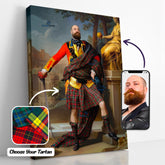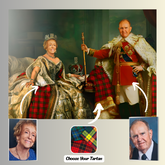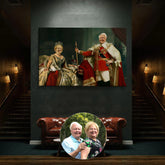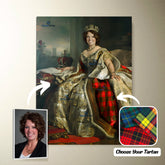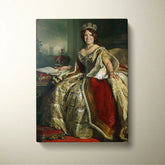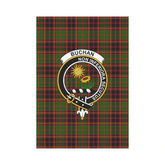-
Clan Buchan Ancient Tartan Crest Umbrella RN89 - Buchan Ancient Tartan Clan
Buchan Ancient Tartan Clan Crest Umbrella RN89 Product Detail: Each umbrella is constructed from a premium waterproof polyester fabric that's durable and will keep you protected in any weather. 18.27 Oz. Made from 100% polyester pongee waterproof fabric. Using heat sublimation technique to prevent...- $49.25
- $49.25
- Unit price
- per
- Buchan Ancient Tartan Clan
-
Clan Buchan Modern Tartan Sun Shade 2 Pieces NT12 - Buchan Modern Tartan Clan
Buchan Modern Tartan Clan Sun Shade 2 Pieces NT12 Car Sun Shade 28'x28'x2pcs Merging anti-UV coating and aluminized film cushion, this car sun shade can protect seatsand dashboards from cracking due to sun damage while also keeping them cool to the touch.' Material: 100...- $56.25
- $56.25
- Unit price
- per
- Buchan Modern Tartan Clan
-
Clan Buchan Ancient Tartan Sun Shade 2 Pieces AU87 - Buchan Ancient Tartan Clan
Buchan Ancient Tartan Clan Sun Shade 2 Pieces AU87 Car Sun Shade 28'x28'x2pcs Merging anti-UV coating and aluminized film cushion, this car sun shade can protect seatsand dashboards from cracking due to sun damage while also keeping them cool to the touch.' Material: 100...- $56.25
- $56.25
- Unit price
- per
- Buchan Ancient Tartan Clan
-
Clan Buchan Tartan Crest Keychain LX75 - Buchan Tartan Clan
Buchan Tartan Clan Crest Keychain LX75 Product detail: This personalized keychain for pictures are the perfect choice for a fun gift idea, the choice is yours to come up with a surprise for someone you love. The keychain is made of PMMA, environmentally, friendly,...- From $15.25
- From $15.25
- Unit price
- per
- Buchan Tartan Clan
-
Clan Buchan Tartan Unisex Baseball Jersey EI21JW24 - Buchan Tartan
Buchan Tartan Clan Unisex Baseball Jersey EI21JW24 Product Detail: Each of our baseball jerseys is custom-made-to-order and handcrafted to the highest quality standards. It is not only extremely soft to the touch but breathable as well. Our jersey is printed on sustainable fabrics so...- $42.25
- $42.25
- Unit price
- per
- Buchan Tartan
-
Clan Buchan Modern Tartan Crest Tumbler AP50 - Buchan Modern Tartan Clan
Buchan Modern Tartan Clan Crest Tumbler AP50 Product Detail: Buchan Modern Tartan Crest Tumbler Introducing our Tartan Tumbler, a perfect companion for your daily hydration needs. This mobile tumbler comes with a slide lid and an ideal size, providing convenience as you enjoy your...- From $45.99
- From $45.99
- Unit price
- per
- Buchan Modern Tartan Clan
-
Clan Buchan Ancient Tartan Crest Tumbler HK81 - Buchan Ancient Tartan Clan
Buchan Ancient Tartan Clan Crest Tumbler HK81 Product Detail: Buchan Ancient Tartan Crest Tumbler Introducing our Tartan Tumbler, a perfect companion for your daily hydration needs. This mobile tumbler comes with a slide lid and an ideal size, providing convenience as you enjoy your...- From $45.99
- From $45.99
- Unit price
- per
- Buchan Ancient Tartan Clan
-
Clan Buchan Tartan Crest Black Garden Flag QY30 - Buchan Tartan Clan
Buchan Tartan Clan Crest Black Garden Flag QY30 Product Detail: Welcome guests to your home with this seasonal flag. Available in 2 sizes: Small size 12'x18' and Large size 28'x40' Material: 100% polyester, PU and carbon black. Weatherproof and fade resistant fabric will not...- $35.45
- $35.45
- Unit price
- per
- Buchan Tartan Clan
-
Clan Buchan Modern Tartan Crest Garden Flag - Welcome CV17 - Buchan Modern Tartan Clan
Buchan Modern Tartan Clan Crest Garden Flag - Welcome CV17 Product Detail: Welcome guests to your home with this seasonal flag. Available in 2 sizes: Small size 12'x18' and Large size 28'x40' Material: 100% polyester, PU and carbon black. Weatherproof and fade resistant fabric...- $35.45
- $35.45
- Unit price
- per
- Buchan Modern Tartan Clan
-
Clan Buchan Modern Tartan Crest Garden Flag - Celtic Thistle UT88 - Buchan Modern Tartan Clan
Buchan Modern Tartan Clan Crest Garden Flag - Celtic Thistle UT88 Product Detail: Welcome guests to your home with this seasonal flag. Available in 2 sizes: Small size 12'x18' and Large size 28'x40' Material: 100% polyester, PU and carbon black. Weatherproof and fade resistant...- $35.45
- $35.45
- Unit price
- per
- Buchan Modern Tartan Clan
-
Clan Buchan Modern Tartan Crest Garden Flag PT29 - Buchan Modern Tartan Clan
Buchan Modern Tartan Clan Crest Garden Flag PT29 Product Detail: Welcome guests to your home with this seasonal flag. Available in 2 sizes: Small size 12'x18' and Large size 28'x40' Material: 100% polyester, PU and carbon black. Weatherproof and fade resistant fabric will not...- $35.45
- $35.45
- Unit price
- per
- Buchan Modern Tartan Clan
-
Clan Buchan Modern Tartan Crest Black Garden Flag - Gold Thistle AX81 - Buchan Modern Tartan Clan
Buchan Modern Tartan Clan Crest Black Garden Flag - Gold Thistle AX81 Product Detail: Welcome guests to your home with this seasonal flag. Available in 2 sizes: Small size 12'x18' and Large size 28'x40' Material: 100% polyester, PU and carbon black. Weatherproof and fade...- $35.45
- $35.45
- Unit price
- per
- Buchan Modern Tartan Clan
-
Clan Buchan Ancient Tartan Crest Garden Flag - Welcome LE48 - Buchan Ancient Tartan Clan
Buchan Ancient Tartan Clan Crest Garden Flag - Welcome LE48 Product Detail: Welcome guests to your home with this seasonal flag. Available in 2 sizes: Small size 12'x18' and Large size 28'x40' Material: 100% polyester, PU and carbon black. Weatherproof and fade resistant fabric...- $35.45
- $35.45
- Unit price
- per
- Buchan Ancient Tartan Clan
-
Clan Buchan Ancient Tartan Crest Garden Flag - Celtic Thistle KM16 - Buchan Ancient Tartan Clan
Buchan Ancient Tartan Clan Crest Garden Flag - Celtic Thistle KM16 Product Detail: Welcome guests to your home with this seasonal flag. Available in 2 sizes: Small size 12'x18' and Large size 28'x40' Material: 100% polyester, PU and carbon black. Weatherproof and fade resistant...- $35.45
- $35.45
- Unit price
- per
- Buchan Ancient Tartan Clan
-
Clan Buchan Ancient Tartan Crest Black Garden Flag - Gold Thistle TI24 - Buchan Ancient Tartan Clan
Buchan Ancient Tartan Clan Crest Black Garden Flag - Gold Thistle TI24 Product Detail: Welcome guests to your home with this seasonal flag. Available in 2 sizes: Small size 12'x18' and Large size 28'x40' Material: 100% polyester, PU and carbon black. Weatherproof and fade...- $35.45
- $35.45
- Unit price
- per
- Buchan Ancient Tartan Clan
-
Clan Buchan Tartan Crest Premium Blanket Thistle Style QK20 - Buchan Tartan Clan Crest Premium Blanket - Thistle Style
Buchan Tartan Clan Crest Premium Blanket Thistle Style QK20 Product detail: Each blanket features a premium suede polyester print for beautiful color vibrancy. Cozy underside is constructed from an ultra-soft micro fleece fabric to keep you warm and comfortable. Perfect for snuggling while watching...- $65.02
- $65.02
- Unit price
- per
- Buchan Tartan Clan Crest Premium Blanket - Thistle Style
-
Clan Clan Buchan Modern Tartan Gold Courage Symbol Blanket PI48 - Buchan Modern Tartan
Buchan Modern Tartan Gold Courage Symbol Blanket PI48 Product Detail: Each blanket features a premium suede polyester print for beautiful color vibrancy. Cozy underside is constructed from an ultra-soft micro fleece fabric to keep you warm and comfortable. Perfect for snuggling while watching TV...- $65.02
- $65.02
- Unit price
- per
- Buchan Modern Tartan
-
Clan Buchan Modern Tartan Crest Premium Blanket Celtic Stag Style RD81 - Buchan Modern Tartan Clan
Buchan Modern Tartan Clan Crest Premium Blanket Celtic Stag Style RD81 Product detail: Each blanket features a premium suede polyester print for beautiful color vibrancy. Cozy underside is constructed from an ultra-soft micro fleece fabric to keep you warm and comfortable. Perfect for snuggling...- From $65.02
- From $65.02
- Unit price
- per
- Buchan Modern Tartan Clan
-
Clan Buchan Modern Tartan Crest Blanket Wave Style BH90 - Buchan Modern Tartan Clan
Buchan Modern Tartan Clan Crest Blanket Wave Style BH90 Product Detail: Each blanket features a premium suede polyester print for beautiful color vibrancy. Cozy underside is constructed from an ultra-soft micro fleece fabric to keep you warm and comfortable. Perfect for snuggling while watching...- $65.02
- $65.02
- Unit price
- per
- Buchan Modern Tartan Clan
-
Clan Clan Buchan Crest Tartan Premium Blanket Black MO25 - Buchan Clan Crest Tartan
Buchan Clan Crest Tartan Premium Blanket Black MO25 Product detail: Each blanket features a premium suede polyester print for beautiful color vibrancy. Cozy underside is constructed from an ultra-soft micro fleece fabric to keep you warm and comfortable. Perfect for snuggling while watching TV...- $65.02
- $65.02
- Unit price
- per
- Buchan Clan Crest Tartan
Ex: Your Tartan + Product
Popular Products
Turn Me Royal Personalized Portrait from Your Photo, Custom Tartan. Custom Canvas Wall Art as Gift for Men
- From $32.45
- From $32.45
- Unit price
- / per
Royalty Couple Personalized Portrait from Your Photo, Custom Tartan. Custom Canvas Wall Art
- From $47.45
- From $47.45
- Unit price
- / per
The Queen Personalized Portrait from Your Photo, Custom Tartan. Custom Canvas Wall Art as Gift for Women
- From $32.45
- From $32.45
- Unit price
- / per
List Of Tartan
-
Clan A
- Abercrombie Tartan
- Aberdeen Tartan
- Abernethy Tartan
- Adair Tartan
- Adam Tartan
- Ayrshire Tartan
- Agnew Tartan
- Aikenhead Tartan
- Ainslie Tartan
- Aiton Tartan
- Allan Tartan
- Alexander Tartan
- Allardice Tartan
- Allison Tartan
- Anderson Tartan
- Angus Tartan
- Anstruther Tartan
- Arbuthnot Tartan
- Armstrong Tartan
- Arnott Tartan
- Auchinleck Tartan
- Ayrshire Tartan
-
Clan B
- Baillie Tartan
- Bain Tartan
- Baird Tartan
- Balfour Tartan
- Bannatyne Tartan
- Bannerman Tartan
- Barclay Tartan
- Baxter Tartan
- Beaton Tartan
- Bell Tartan
- Belshes Tartan
- Bethune Tartan
- Beveridge Tartan
- Binning Tartan
- Bisset Tartan
- Blackadder Tartan
- Blackstock Tartan
- Black Watch Tartan
- Blair Tartan
- Blane Tartan
- Blyth Tartan
- Borthwick Tartan
- Boswell Tartan
- Bowie Tartan
- Boyd Tartan
- Boyle Tartan
- Brisbane Tartan
- Brodie Tartan
- Brown/ Broun Tartan
- Bruce Tartan
- Buccleuch Tartan
- Buchan Tartan
- Buchanan Tartan
- Burnett Tartan
- Burns Tartan
- Butter Tartan
- Byres Tartan
-
Clan C
- Cairns Tartan
- Calder Tartan
- Callander Tartan
- Cameron Tartan
- Campbell Tartan
- Campbell of Breadalbane Tartan
- Campbell of Cawdor Tartan
- Carmichael Tartan
- Carnegie Tartan
- Carruthers Tartan
- Cathcart Tartan
- Chalmers Tartan
- Charteris Tartan
- Chattan Tartan
- Cheyne Tartan
- Chisholm Tartan
- Christie Tartan
- Clark Tartan
- Clelland Tartan
- Clephan Tartan
- Clergy Tartan
- Cochrane Tartan
- Cockburn Tartan
- Colquhoun Tartan
- Colville Tartan
- Cooper Tartan
- Couper Tartan
- Craig Tartan
- Cranstoun Tartan
- Crawford Tartan
- Crichton Tartan
- Crief District Tartan
- Crosbie Tartan
- Cumming Tartan
- Cunningham Tartan
- Currie Tartan
- Clan D
- Clan E
- Clan F
- Clan G
- Clan H
- Clan I
- Clan J
- Clan K
- Clan L
-
Clan M
- Maitland Tartan
- Malcolm Tartan
- Mar Tartan
- Marjoribanks Tartan
- Maxtone Tartan
- Matheson Tartan
- Maule Tartan
- Maxwell Tartan
- Meldrum Tartan
- Melville Tartan
- Menzies Tartan
- Mercer Tartan
- Middleton Tartan
- Moffat Tartan
- Moncrieffe Tartan
- Montgomery Tartan
- Monypenny Tartan
- Moncreiffe Tartan
- Monteith Tartan
- Morrison Tartan
- Mouat Tartan
- Moubray Tartan
- Mow Tartan
- Muir_More Tartan
- Muirhead Tartan
- Munro Tartan
- Murray Tartan
- Murray of Atholl Tartan
-
Clan Mc/Mac
- MacAlister Tartan
- MacArthur Tartan
- MacAlpine Tartan
- MacAulay Tartan
- MacBain Tartan
- MacBean Tartan
- MacBeth Tartan
- MacCallum Tartan
- MacCraig Tartan
- MacColl Tartan
- MacCorquodale Tartan
- MacDiarmid Tartan
- MacDonald Tartan
- MacDonald of Clanranald Tartan
- MacDonald of Sleat Tartan
- MacDonnell of Glengarry Tartan
- MacDonnell of Keppoch Tartan
- MacDougall Tartan
- MacDowall Tartan
- MacDuff Tartan
- MacEwen_MacEwan Tartan
- MacEdward Tartan
- MacFarlane Tartan
- MacGill Tartan
- MacGillivray Tartan
- MacGregor Tartan
- MacGowan (McGowan) Tartan
- MacHardy Tartan
- MacIan Tartan
- MacInnes Tartan
- MacIntyre Tartan
- MacKay Tartan
- MacKillop Tartan
- MacKellar Tartan
- Mackinlay Tartan
- MacKenzie Tartan
- Mackie Tartan
- MacKinnon Tartan
- MacKintosh / MacIntosh Tartan
- MacLeod Tartan
- MacMillan Tartan
- MacNab Tartan
- MacNaughton Tartan
- MacNeil / MacNeill Tartan
- MacNeil of Colonsay Tartan
- MacNicol Tartan
- MacPhail Tartan
- MacPhee_MacFie Tartan
- MacPherson Tartan
- MacQuarrie Tartan
- MacQueen Tartan
- MacRae Tartan
- MacRow Tartan
- MacSporran Tartan
- MacTaggart Tartan
- MacTavish Tartan
- MacThomas Tartan
- McCorquodale Tartan
- McCulloch Tartan
- McFadzen Tartan
- McGeachie Tartan
- McIver Tartan
- McKerrell Tartan
- Clan N
- Clan O
- Clan P
- Clan R
-
Clan S
- Sandilands Tartan
- Scott Tartan
- Scrymgeour Tartan
- Selkirk Tartan
- Sempill Tartan
- Seton Tartan
- Shaw Tartan
- Shepherd Tartan
- Sinclair Tartan
- Skene Tartan
- Skirving Tartan
- Smith Tartan
- Somerville Tartan
- Spalding Tartan
- Spens Tartan
- Spottiswood Tartan
- Stevenson Tartan
- Stewart Tartan
- Stewart of Appin Tartan
- Stirling Tartan
- Strachan Tartan
- Straiton Tartan
- Strange Tartan
- Strathclyde District Tartan
- Stuart of Bute Tartan
- Sutherland Tartan
- Swinton Tartan
- Clan T
- Clan U W Y
- Request Your Clan
Clan Buchan (Buchan Tartan)
1. About Clan Buchan (Buchan Tartan)
2. Clan Buchan History (Buchan Tartan)
It is crucial to note, however, that local nobles would have also used the name, even if they might not have had a clear connection to their Earls.
The family began to exert influence over Auchmacoy from the beginning of the 14th century, but it wasn't until James IV granted Andrew, the second chief, a charter to the lands in 1503 that they came under their control.
Throughout a protracted battle with General Mackay's government forces, Buchan guided the Jacobite forces.
3. Clan Buchan Tartans
While "modern" refers to darker dye colours, "ancient" refers to the dye shades, which are typically lighter.
Threadcount K/4 R4 G54 R4 K12 B4 G12 R4 K48 R4 K4 B4 R4 K48 R4 G12 R12 B4 K12 R4 G54 R4 K/4
4. Clan Buchan Crest & Coats of Arms
4.1 Clan Buchan Crest
Worn by all of the name and ancestry
4.2 Clan Buchan Coat of Arms
5. Clan Buchan Places & People
5.1 Clan Buchan Places
Auchmacoy House
The Clan Buchan has owned the Auchmacoy estate in Aberdeenshire for more than 700 years. In 1830, the former Auchmacoy House was replaced by the present structure.
5.2 Clan Buchan People
Alexander Buchan (11 April 1829 - 13 May 1907)
The name "Buchan Spells," which derives from Alexander Buchan, who first observed these aberrations from the typical predicted seasonal temperatures, is often used in meteorology. He made the weather map the cornerstone of weather prediction.
5.3 John Buchan (26 August 1875 - 11 February 1940)
Son of a minister who attended Glasgow and Oxford colleges before being admitted to the bar in 1901. He is renowned for penning "The Thirty-nine Steps," which Alfred Hitchcock popularized in his movie of the same name.
From 1935 until his passing at the age of 64 in 1940, Buchan served as Canada's 15th governor general.
6. Associated Names
Although there are no recognized septs within Clan Buchan, the following surnames have been associated with the Buchan region in Scotland's northeast:
Basken, Baskin, Bede, Bichan, Bichen, Bonnieville, Boyne, Buck, Buckie, Bucky, Cawsell, Chapp, Chrystal, Clapperton, Coscrach, Costie, Costy, Cranach, Crannach, Cruddon, Cruden, Crudon, Crystal, Crystal, Crystall, Fitchie, Fitchy, Gammerie, Gammery, Hardin, Hardman/ Hardnan, Kermack, Leisk, Mac, Meason, Merson, Mondie, Mondy, Mundie, Mundy, Nible, Niblo, Ogston, Ogstone, Ogstoun, Prince, Ratcliff, Ratliff, Rattcliff, Rattliff, Runcie, Runcy, Shakle, Tarves, Tarvis, Teunion, Teunon, Tewnion, Tinnon, Tucks, Wadsworth, Wadsworther, West, Whammond, Whyman, Whymon, and Willgook
- Choosing a selection results in a full page refresh.

